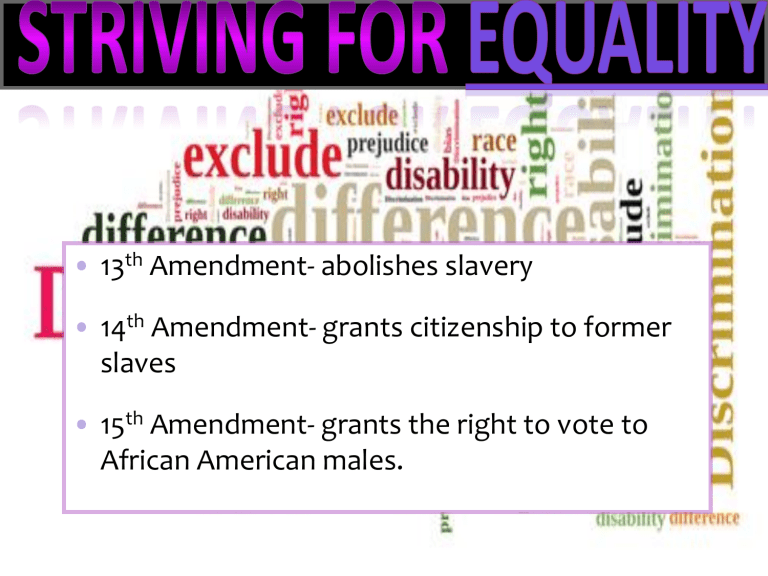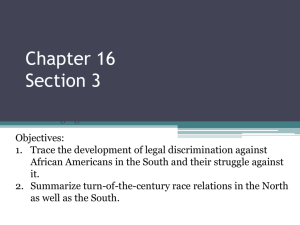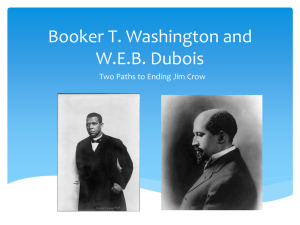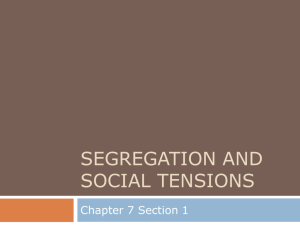
• 13th Amendment- abolishes slavery • 14th Amendment- grants citizenship to former slaves • 15th Amendment- grants the right to vote to African American males. WHAT IS DISCRIMINATION? • Discrimination involves: • Beliefs : "This group of people is inferior because" • Emotions : "I hate this group of people." • Actions : "I will deny opportunity/hurt/kill members of this group." VOTING RESTRICTIONS • All Southern states imposed new voting restrictions and denied legal equality to African Americans. • Some states limited the vote to those who could read, other states had a poll tax which had to be paid prior to voting. $1.50 in 1932 = $24.12 in 2015 More Voting Restrictions: • Since there were some white men that couldn‘t pass the simple literacy test, a Grandfather Clause was created. • Grandfather Clause – Men were allowed to vote if he, his father, or his grandfather had been eligible to vote before January 1, 1867. • African Americans couldn‘t vote before 1867!!! • Southern states passed Segregation Laws separated white and black people in public and private facilities. • These laws came to be known as “Jim Crow Laws” - Racial segregation in schools, hospitals, parks, and transportation systems throughout the South. Jim Crow Laws Homer Plessy • In 1896, in Plessy v. Ferguson the Supreme Court ruled that the segregation of races was legal and did not violate the 14th Amendment. • “Separate but equal” • This decision legalized racial segregation for almost 60 years. • As discrimination and violence became increasingly common, black leaders began to seek solutions for the race problems. • In 1905, many black leaders met to discuss the problem at the Niagara Conference in Ontario, Canada. The World of Jim Crow National Advancement of Colored People • Out of this conference came the formation of the National Association for the Advancement of Colored People (NAACP) in 1909. RACE RELATIONS - 1900 • Blacks faced legal discrimination as well as informal rules and customs. • Meant to humiliate these “rules” included; whites never shaking the hand of an African America, blacks had to yield the sidewalk to whites, blacks also had to remove their hats in the presence of whites. VIOLENCE • African Americans who did not follow the racial etiquette could face severe punishment or death • Between 1882-1892, more than 1,400 black men and women were shot, burned, or lynched • Lynching peaked in the 1880s and1890s but continued well into the 20th century Lynching's: By State and Race, 1882-1968* State White Black Total State Maryland Michigan Minnesota Mississippi Missouri Montana Nebraska Nevada New Jersey New Mexico New York North Carolina North Dakota Ohio Oklahoma Oregon Alabama Arizona Arkansas California Colorado Delaware Florida Georgia 48 31 58 41 65 0 25 39 299 0 226 2 3 1 257 492 347 31 284 43 68 1 282 531 Idaho Illinois Indiana Iowa Kansas Kentucky Louisiana Maine 20 15 33 17 35 63 56 1 0 19 14 2 19 142 335 0 20 34 47 19 54 205 391 1 White 2 7 5 42 53 82 52 6 1 33 1 15 13 10 82 20 Black Total 27 1 4 539 69 2 5 0 1 3 1 86 3 16 40 1 29 8 9 581 122 84 57 6 2 36 2 101 16 26 122 21 State Pennsylvania South Carolina South Dakota Tennessee Texas Utah Vermont Virginia Washington West Virginia Wisconsin Wyoming Total 1,297 White Black Total 2 6 8 4 156 160 27 0 27 47 204 251 141 352 493 6 2 8 1 0 1 17 83 100 25 1 26 20 28 48 6 0 6 30 5 35 3,446 4,743 *Statistics provided by the Archives at Tuskegee Institute. MAJOR AREAS OF LYNCHING DISCRIMINATION IN THE NORTH • While most African Americans lived in the segregated South, many blacks had migrated to the North in hopes of better jobs & equality • However, the North had its own brand of racism as blacks got low paying jobs and lived in segregated neighborhoods DISCRIMINATION IN THE WEST • Discrimination in the west was most often directed against Mexican and Asian immigrants • Mexicans were often forced in Debt Peonage – a system of forced labor due to debt • Asians were increasingly excluded from mainstream society and entering the United States for work through the Chinese Exclusion Act. “Liberation of the Peon” by Diego Rivera What voting restrictions were placed on African Americans in the South? • Poll taxes • Grandfather clause What impact did Jim Crow Laws have? • Separated whites and black in facilities. What significance did Plessy vs. Ferguson have on the United States? • Legalized racial segregation • “Separate but equal” How were Booker T. Washington and W.E.B. Du Bois similar? • African American • More rights, education & equality for blacks. How did Mexicans face discrimination in the West? • Debt Peonage- forced labor because of debt. How did Chinese face discrimination in the West? • Chinese Exclusion Act- No Chinese workers.




